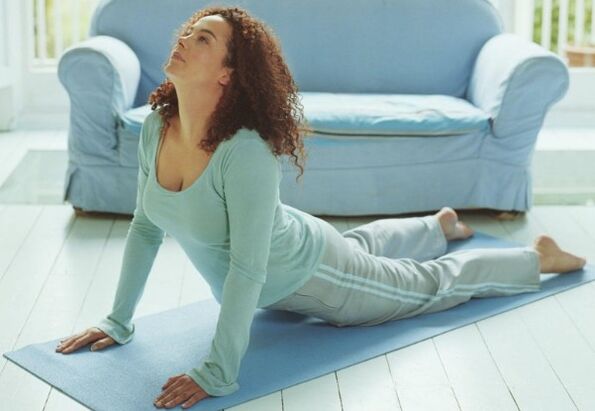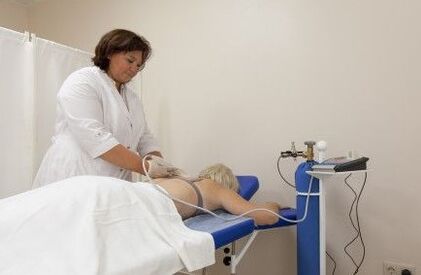The cervical spine osteochondrosis is a very common disease, against which dystrophic changes occur in the cartilage tissue, in the discs between the vertebrae and the base of the bone in them. This pathology develops in many people who have reached the age of 30. Symptoms for cervical osteochondrosis are varied, so it is quite difficult to diagnose the disease and choose the right treatment.

Factors provoking the occurrence of the disease
Cervical osteochondrosis can develop under the influence of the following factors:
excess weight;
sedentary work, inactivity;
previous spinal column damage;
mental disorders, nerve overload, stress;
poor physical training;
curvature of the spine, scoliosis, improper behavior;
the wrong position of the body, which has become a habit;
tension in the neck, back during surgery;
tendency to the genetic level;
unusual for the body of physical stress, increased activity;
Internal food.
The cervical region of the spine is subjected to increased loads, which the cervical muscles are trying to lead to balance during the influence of the above resources. This provokes the appearance of muscle spasm, due to which there is a violation of blood transport throughout the body. As a result, the formation of anatomical damage is marked.
The degree of osteochondrosis
In the process of developing cervical osteochondrosis, the discs between the vertebrae are weakened, due to which the structure in the discs, beads, articular fabric of the cervical region changes. First -rate disease continues almost asymptomatic, as changes in cartilage are starting. In this case, a person complains about the appearance:
headache;
discomfort in the neck, arms, shoulders;
minor restrictions on neck motor activity;
short -term landing in visual function;
Reduction of sensitivity in the collar area.
The second stage is sometimes associated with the appearance of a small vertebral hernia as well as the narrowing of the cracks between the vertebrae. Due to the violation of nerve receptors, there is a feeling of point pain in the process of movements. Contrary to the backdrop of a second -degree disease, the patient notes the appearance:
Neck pain syndrome, pressing with head movements;
loss of skin sensitivity in the area of the arms and shoulders;
decreased visual function;
ears ringing;
 numbness in the face and neck;
weaknesses in the hands;
Shooting pain giving to shoulder blade;
Disorders in sleep functions.
numbness in the face and neck;
weaknesses in the hands;
Shooting pain giving to shoulder blade;
Disorders in sleep functions.
It is very difficult to treat osteochondrosis of the third degree cervical region. At this time, a hernia develops, the spinal column is deformed, marked position changes, displacements on the ridge elements are observed. This stage of the disease is associated with:
Pronounced pain in the neck, myocardial, the collar area;
lack of skin sensitivity to the head, arms and shoulders;
hand paralysis;
lack of tendon reflexes;
Forming a hernia in the cervical vertebrae.
In the fourth (final) phase process, a deterioration of the signs is marked.
Symptoms
Signs of neck disease are significantly different from the symptoms of osteochondrosis in another area of the vertebral column.Since the cervical vertebrae are located nearby, the nerve roots and the spinal cord are glued.This leads to the appearance of such signs:
The pain syndrome is localized in the neck, nap, shoulders, arms and legs. At the time of joining the nerve receptors, the appearance of unpleasant sensations in the shoulder area, the back of the head, the hands begin to be rebuilt. Due to spasm in the cervical muscles, the bloodstream is disturbed.
There is a occurrence of weakness in the upper extremities, accompanied by damage to the functionality of the roots, which contribute to the inclusion of motor nerves that rebuild muscle tissue in the hands.
The upper limbs are rebuilt due to a decrease in sensitivity in them, violations of the roots in which sensitive nerve endings are located.
When you turn your head, painful sensations appear, you can also hear a crisis. This is explained by damage to the small joints of the cervical region, a decrease in the level of the intervertebral discs.
The patient complains of insufficient strength, the appearance of fatigue, dizziness, coordination disorders. Due to the displacement of the spine elements, the vertebral artery is squeezed. Because of this, the bloodstream worsens, which leads to a weakening of blood supply in the occipital section and cerebellum.
The appearance of problems with vision is observed, the loss of sensitivity in the tongue has been observed.
Symptoms for cervical osteochondrosis in women are no different from signs in men. Women who have reached the age of 45 and older, who are diagnosed with such a disease, mark numbness and tingling in the upper limbs in a dream.
What is the risk of osteochondrosis of the cervical region
The disease can damage the body as a whole. In the neck are located in a significant volume of arteries, nerve receptors, blood vessels through which the brain is supplied. If a mild illness occurs, they are squeezed.This provokes the emergence of problems in the blood supply of the brain.As a result, migraine formation, heart rhythm disorders, problems with respiratory and visual function, coordination and attention are also damaged.
In contrast to the backdrop of osteochondrosis of the neck, the formation of such diseases is possible:
pathology in the brain;
Arterial vessel syndrome on the back;
spinal cord.
The most severe complication is the death of the patient, which can occur when squeezing the spinal canal. Symptoms and treatment of cervical osteochondrosis are due to the stage of the disease.
Therapeutic actions for cervical osteochondrosis
Therapy for cervical spine osteochondrosis is prescribed, regardless of the patient's sexual sex. Treatment takes place in several stages:
Removing painful manifestations.
Elimination of swelling.
Blood circulation to the norm.
Muscle fixation on the back, abdominal press, chest.
Improving the quality of nutrition and regeneration of the spine of the tissue.
If even trivial signs of the disease are found, you should consult a specialist. With such a pathology, an integrated approach is used, an inspection of a surgeon, neuropathologist, physiotherapist and manual therapist is required.
For therapeutic purposes, against the backdrop of cervical osteochondrosis, medicines, physiotherapeutic treatment, a collar massage and use physiotherapy exercises, as it is very effective in this condition.
Medication
When they detect the neck osteochondrosis, they are described:
Preparations for eliminating muscle spasms;
vitamin remedies to improve metabolic processes in the central nervous system;
NSAID group medication to reduce pain, eliminate the inflammatory process and swelling;
Links to the joints, contributing to the reset of the cartilage, eliminate disorders on the discs between the vertebrae.
Medications that are favorable to improve the nutrition of the affected nerve tissue, regulating blood flow to the brain.
First aid for irritation of cervical osteochondrosis
Sometimes, if the pain syndrome becomes unbearable, but it is not possible to visit a doctor, experts advise to get an analgesic. To relieve the pain, you can be directed to the help of a "pepper piece", but this tool only brings relief for a short time.Patch will help warm the affected area and relieve pain for a while.To get rid of swelling, the use of plant infusions is recommended for 3-4 days.
But it is worth considering that it will not work to recover from cervical osteochondrosis using such methods. These methods help to cope with the signs of the disease only for a short time. To describe full related therapy, you will need to contact the help of a specialist.
Physiotherapeutic procedures
As part of a complex treatment, to improve the effect, use:
Electrophoresis - The ions of an analgesic drug penetrate the affected area due to the effect of electricity. During the procedure, novocaine or lidocaine is usually used.
Laser therapy - it has an anti -inflammatory effect, improves blood circulation through the impact of light.
 Magnetic therapy - helps to get rid of edema in the tissue, has an analgesic effect.
Ultrasound - helps improve metabolism, anesthesia, removes the inflammatory process in the affected area.
Magnetic therapy - helps to get rid of edema in the tissue, has an analgesic effect.
Ultrasound - helps improve metabolism, anesthesia, removes the inflammatory process in the affected area.
Physical education
Also, with cervical osteochondrosis, therapeutic exercises will help improve well -being. It is worth noting that the performance of the exercise should not be associated with pain or discomfort. Complex of Exercises:
We lie down in the stomach and rest on the floor. The back should be even, and the head and body are raised. We remain in this position for about 2 minutes, then return to the starting position. We perform 2-3 repetitions.
At the sink of the floor, we lie on your back, from your arms along the body. We turn our head first to the right then to the right, trying to touch the floor with the ear. We do the exercise 6-7 times in each direction.
We sit on the floor. We breathe and bend our heads forward in an effort to touch the chest with it. In extraction, we throw our head back. Exercise should be repeated 10-15 times.
We sit on the floor, press our hands on the forehead and at the same time lower our heads. Exercise should be done for about 30 seconds, repeated 2-3 times.
Without problems, slowly, we rotate with our heads so that we do not cause dizziness. In the case when the head began to be imagined, the exercise should stop. It is necessary to perform rotations 10 times left then to the right.
Home treatment
Such therapy can only be used as part of a comprehensive treatment prescribed by a physician.At home, you can turn to the help of folk remedies, physiotherapy and massage.
With cervical osteochondrosis, you can use the following recipes:
Place the horseradish sheet on a sludge and fix it with a bandage or fabric. The sheet should be poured with hot water, and then cool to room temperature. Such a bandage is placed before bedtime and leaves until morning.
Grate the potatoes and mix with honey in equal proportions. Apply to set a compress every 7 days.
To weaken the pain, heat will help with mustard, a sand bag, pepper pieces, etc.

Before using all funds, it is recommended to request a doctor's consultation.
Massage
Healing massage can be performed at home. You should start massive a healthy body area, gradually moving to the affected area. The massage complex must be selected taking into account the individual characteristics of the patient, the degree of neglect of the disease. Massage should be performed by the patient, placing it horizontally on the floor. You have to put your palms on your forehead, and my beard is lengthening towards your chest. The neck muscles should be smooth.
Massage is performed as follows:
First we massage the collar area with shock movements.
Then go to the squeeze. To do this, place your hands on your neck and move along the spine. Also, this technique can be used when massaged in the shoulder.
To warm the neck muscles, we rub it. This will help the body rest, improve blood circulation. You need to move from the skull along the spine using circular movements.
The last movement is a vibration that is carried out thanks to shaking and shocking.
Prevention
To prevent the development of cervical osteochondrosis, recommended:
Sport (the ideal option is to visit the pool).
Put products with calcium and magnesium in the diet.
Wash it several times during the day, especially when you are busy in a sitting job.
In accordance with the requirements, to replace the pillow (buy a low one) and mattress (you need hard enough). Follow the neck of the neck in a dream: the neck should bend at least 15 degrees.
Take a hot shower for at least 10 minutes all day.
People who do not welcome sports, doctors recommend periodically attending the Yoga section.
Do not be involved in simulators, as this can lead to a deterioration in well -being.






























































































